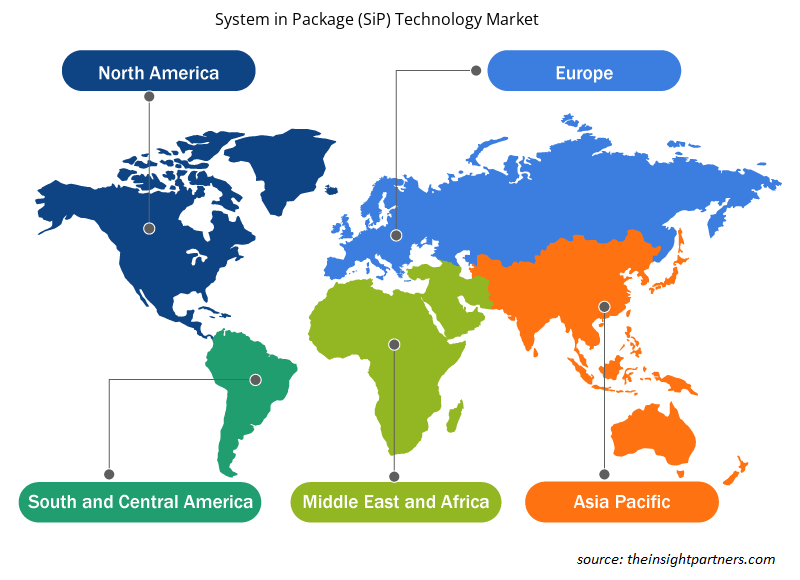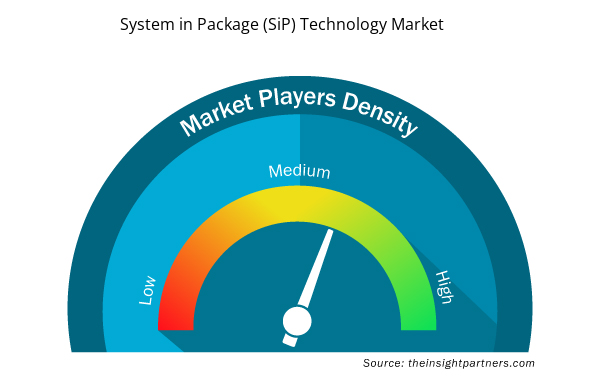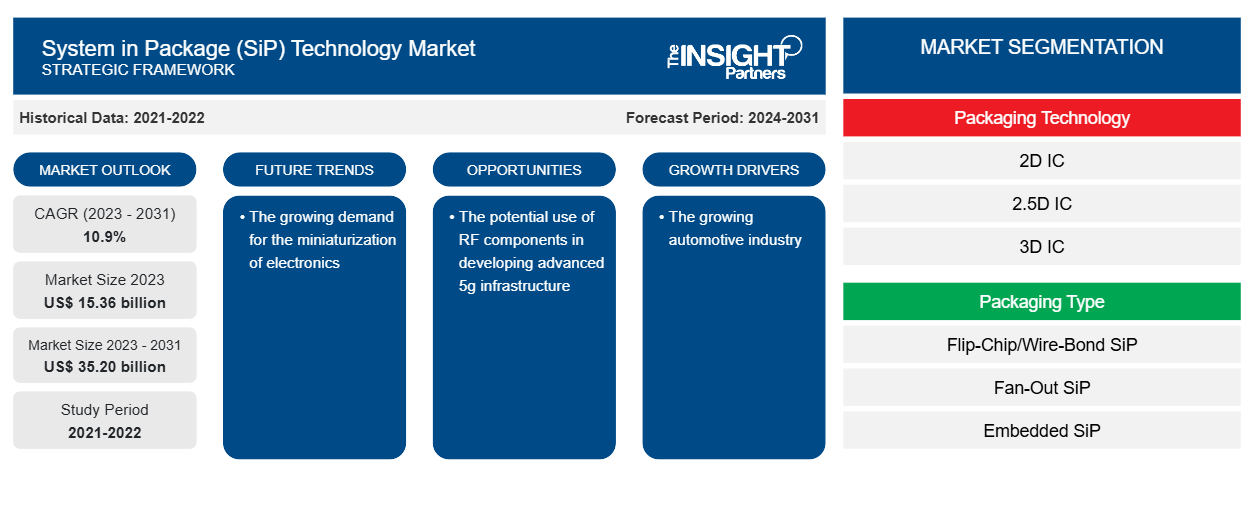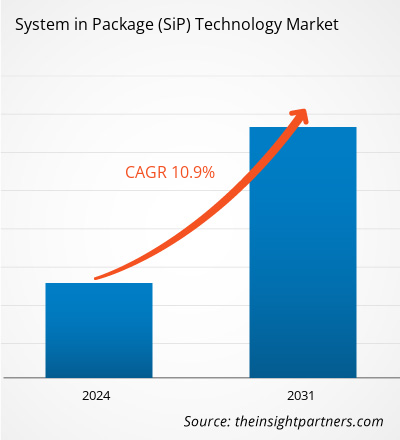システムインパッケージ(SiP)技術の市場規模は、2023年の153.6億米ドルから2031年には352億米ドルに達すると予測されています。市場は2023年から2031年にかけて10.9%のCAGRを記録すると予想されています。電子機器の小型化に対する需要の高まりは、システムインパッケージ(SiP)技術市場の重要なトレンドであり続けると思われます。
システムインパッケージ(SiP)技術市場分析
5Gネットワーク接続デバイスの導入、インターネット接続機能を備えた小型電子機器の需要増加、モノのインターネット(IoT)デバイスの普及により、世界的なシステムインパッケージ(SiP)技術ビジネスの成長が促進されると予測されています。さらに、スマートフォンやスマートウェアラブルの使用増加により、業界は発展しています。ただし、統合レベルが高くなると熱の問題が発生する可能性があり、これは大きな市場制約となります。逆に、アジア太平洋地域からの強い需要は、予測期間全体にわたって市場拡大を支えると予想されます。
システムインパッケージ(SiP)技術市場の概要
「システム イン パッケージ」(SiP) として知られるパッケージング技術は、多数の受動および電気サブコンポーネントを 1 つの基板上に統合します。システム イン パッケージ (SiP) 技術の主な利点の 1 つは、多数のダイを備えた IC パッケージをIC パッケージ内のアクティブ システムまたはサブシステムと組み合わせることができることです。システム イン パッケージ (SiP) 技術の市場拡大は、発展途上国、特に自動車分野での SiP 製品の採用増加によって促進されると予想されています。市場は、マイクロエレクトロニクス デバイスの回路小型化のニーズの高まりなどの要因により、より急速に拡大しています。さらに、パッケージ設計の最新のトレンドはシステムです。
要件に合わせてレポートをカスタマイズする
このレポートの一部、国レベルの分析、Excelデータパックなど、あらゆるレポートを無料でカスタマイズできます。また、スタートアップや大学向けのお得なオファーや割引もご利用いただけます。
- このレポートの主要な市場動向を入手してください。この無料サンプルには、市場動向から見積もりや予測に至るまでのデータ分析が含まれます。
システムインパッケージ(SiP)技術市場の推進要因と機会
成長する自動車産業
自動車部門、特に電気自動車は、化石燃料に対する敏感性の高まりと、よりクリーンな環境に向けた政府の対策の増加により、予測期間中に成長を遂げるでしょう。たとえば、自動車部門では、ゼネラルモーターズなどの大手企業が2021年に自律走行車(無人運転車)を発売する予定であり、一方AUDIはNvidiaと協力して、人間が監視しない自動車モデルの機能を開発しました。この高度に自動化された自動車のプロトタイプは、AUDIのQ7車種に基づいています。SIP技術は、スマートカーや電気自動車の電気部品、たとえばパワーモジュール(ADI µModules)、センサー(MEMS)、トランスミッション制御ユニット、車両中央インフォテインメントユニット、シングルチップモジュールなどに使用されています。このように、成長する自動車産業は、システムインパッケージ(SiP)技術市場の成長を推進しています。driverless car) cars in 2021, while AUDI collaborated with Nvidia to develop a capability for non-human supervised car models. The prototype of this highly automated car is based on AUDI’s Q7 car model. SIP technology is used in smart and ADI µModules), sensors (MEMS), transmission control units, vehicle central infotainment units, single-chip modules, etc. Thus, the growing automotive industry is propelling the System in Package (SiP) technology market growth.
高度な5Gインフラの開発におけるRFコンポーネントの潜在的な利用
今後 5 年間で、高帯域幅をサポートする機器が利用可能になるため、ワイヤレス ネットワークで大きな混雑が発生するでしょう。これにより、現在の 3G および 4G LTE テクノロジから 5G への移行が加速されます。5G テクノロジにより、現在の 4G および 3G のデータ レートよりも大幅に高速な総合データ レートが実現されると予想されます。
米国、日本、韓国、英国、ドイツ、中国を含む多くの主要国が、2021年までに5Gテクノロジーを導入すると予想されています。これにより、モバイル加入者数が大幅に増加し、ユーザーのデータ需要を処理できるインフラストラクチャの開発が必要になると予想されます。その結果、より多くのデータを配信するために必要なSiPベースのRFコンポーネントが増加するでしょう。したがって、高度な5Gインフラストラクチャの開発におけるRFコンポーネントの潜在的な使用は、予測期間中にシステムインパッケージ(SiP)テクノロジー市場のプレーヤーに新たな機会をもたらすと予想されます。
システムインパッケージ(SiP)技術市場レポートのセグメンテーション分析
システムインパッケージ (SiP) 技術市場分析の導出に貢献した主要なセグメントは、パッケージング技術、パッケージングタイプ、相互接続技術、および最終用途産業です。
- パッケージング技術に基づいて、システムインパッケージ (SiP) 技術市場は、2D IC、2.5D IC、3D IC に分類されます。
- パッケージタイプ別に見ると、市場はフリップチップ、ワイヤボンド、ファンアウト ウェーハレベル パッケージに分類されます。
- 相互接続技術によって、市場はスモールアウトライン、フラットパッケージ、ピングリッドアレイ、表面実装などに分類されます。
- 最終用途産業に基づいて、システムインパッケージ (SiP) テクノロジ市場は、自動車、航空宇宙および防衛、民生用電子機器、通信、その他に分かれています。
システムインパッケージ(SiP)技術の地域別市場シェア分析
システム イン パッケージ (SiP) 技術市場レポートの地理的範囲は、主に北米、アジア太平洋、ヨーロッパ、中東およびアフリカ、南米/中南米の 5 つの地域に分かれています。収益の面では、APAC がシステム イン パッケージ (SiP) 技術市場で最大のシェアを占めています。これは、中国、インド、韓国などの新興経済国からの需要の急増によるものです。
システムインパッケージ(SiP)技術市場の地域別分析
予測期間を通じてシステム イン パッケージ (SiP) テクノロジ市場に影響を与える地域的な傾向と要因は、Insight Partners のアナリストによって徹底的に説明されています。このセクションでは、システム イン パッケージ (SiP) テクノロジ市場のセグメントと、北米、ヨーロッパ、アジア太平洋、中東、アフリカ、南米、中米の地域についても説明します。

- システムインパッケージ(SiP)技術市場の地域別データを入手
システムインパッケージ(SiP)技術市場レポートの範囲
| レポート属性 | 詳細 |
|---|---|
| 2023年の市場規模 | 153.6億米ドル |
| 2031年までの市場規模 | 352億ドル |
| 世界のCAGR(2023年~2031年) | 10.9% |
| 履歴データ | 2021-2022 |
| 予測期間 | 2024-2031 |
| 対象セグメント | パッケージングテクノロジー
|
| 対象地域と国 | 北米
|
| 市場リーダーと主要企業プロフィール |
|
市場プレーヤーの密度:ビジネスダイナミクスへの影響を理解する
システム イン パッケージ (SiP) 技術市場は、消費者の嗜好の変化、技術の進歩、製品の利点に対する認識の高まりなどの要因により、エンド ユーザーの需要が高まり、急速に成長しています。需要が高まるにつれて、企業は提供内容を拡大し、消費者のニーズを満たすために革新し、新たなトレンドを活用し、市場の成長をさらに促進しています。
市場プレーヤー密度とは、特定の市場または業界内で活動している企業または会社の分布を指します。これは、特定の市場スペースに、その市場規模または総市場価値に対してどれだけの競合相手 (市場プレーヤー) が存在するかを示します。
システムインパッケージ(SiP)テクノロジー市場で事業を展開している主要企業は次のとおりです。
- ASEグループ
- アムコーテクノロジー株式会社
- チップモステクノロジーズ株式会社
- 富士通株式会社
- GSナノテック
- 株式会社JCETグループ
免責事項:上記の企業は、特定の順序でランク付けされていません。

- システムインパッケージ(SiP)テクノロジー市場のトップキープレーヤーの概要を入手
システムインパッケージ(SiP)技術市場のニュースと最近の動向
システムインパッケージ (SiP) 技術市場は、主要な企業出版物、協会データ、データベースなどの一次調査と二次調査後の定性的および定量的データを収集することで評価されます。以下は、音声および言語障害の市場と戦略の動向の一覧です。
- 2023 年 3 月、Octavo Systems が発表した OSD62x シリーズのシステムインチップ (Sip) 製品は、次世代アプリケーションで使用するためのエッジおよび小型フォーム ファクタの組み込み処理のパフォーマンスの向上に役立ちます。プロセッサ Texas Instruments (Tl) AM623 および AM625 は、OSD62x ファミリの基盤として機能します。
(出典: Octavo Systems、プレスリリース)
システムインパッケージ(SiP)技術市場レポートの対象範囲と成果物
「システムインパッケージ(SiP)テクノロジー市場の規模と予測(2021〜2031年)」レポートでは、以下の分野をカバーする市場の詳細な分析を提供しています。
- 対象範囲に含まれるすべての主要市場セグメントの世界、地域、国レベルでの市場規模と予測
- 市場の動向(推進要因、制約、主要な機会など)
- 今後の主な動向
- 詳細なPEST/ポーターの5つの力とSWOT分析
- 主要な市場動向、主要プレーヤー、規制、最近の市場動向を網羅した世界および地域の市場分析
- 市場集中、ヒートマップ分析、主要プレーヤー、最近の動向を網羅した業界の状況と競争分析
- 詳細な企業プロフィール
- 過去2年間の分析、基準年、CAGRによる予測(7年間)
- PEST分析とSWOT分析
- 市場規模価値/数量 - 世界、地域、国
- 業界と競争環境
- Excel データセット



Report Coverage
Revenue forecast, Company Analysis, Industry landscape, Growth factors, and Trends

Segment Covered
This text is related
to segments covered.

Regional Scope
North America, Europe, Asia Pacific, Middle East & Africa, South & Central America

Country Scope
This text is related
to country scope.
よくある質問
The global System in Package (SiP) technology market was estimated to be US$ 15.36 billion in 2023 and is expected to grow at a CAGR of 10.9 % during the forecast period 2023 - 2031.
The growing automotive industry and the potential use of RF components in developing advanced 5g infrastructure are the major factors that propel the global System in Package (SiP) technology market.
The growing demand for the miniaturization of electronics is anticipated to play a significant role in the global System in Package (SiP) technology market in the coming years.
The key players holding majority shares in the global System in Package (SiP) technology market are ASE Group, Amkor Technology, Inc., ChipMOS TECHNOLOGIES INC., Fujitsu Ltd., and GS Nanotech.
The global System in Package (SiP) technology market is expected to reach US$ 35.20 billion by 2031.
Trends and growth analysis reports related to Electronics and Semiconductor : READ MORE..
The Insight Partners performs research in 4 major stages: Data Collection & Secondary Research, Primary Research, Data Analysis and Data Triangulation & Final Review.
- Data Collection and Secondary Research:
As a market research and consulting firm operating from a decade, we have published and advised several client across the globe. First step for any study will start with an assessment of currently available data and insights from existing reports. Further, historical and current market information is collected from Investor Presentations, Annual Reports, SEC Filings, etc., and other information related to company’s performance and market positioning are gathered from Paid Databases (Factiva, Hoovers, and Reuters) and various other publications available in public domain.
Several associations trade associates, technical forums, institutes, societies and organization are accessed to gain technical as well as market related insights through their publications such as research papers, blogs and press releases related to the studies are referred to get cues about the market. Further, white papers, journals, magazines, and other news articles published in last 3 years are scrutinized and analyzed to understand the current market trends.
- Primary Research:
The primarily interview analysis comprise of data obtained from industry participants interview and answers to survey questions gathered by in-house primary team.
For primary research, interviews are conducted with industry experts/CEOs/Marketing Managers/VPs/Subject Matter Experts from both demand and supply side to get a 360-degree view of the market. The primary team conducts several interviews based on the complexity of the markets to understand the various market trends and dynamics which makes research more credible and precise.
A typical research interview fulfils the following functions:
- Provides first-hand information on the market size, market trends, growth trends, competitive landscape, and outlook
- Validates and strengthens in-house secondary research findings
- Develops the analysis team’s expertise and market understanding
Primary research involves email interactions and telephone interviews for each market, category, segment, and sub-segment across geographies. The participants who typically take part in such a process include, but are not limited to:
- Industry participants: VPs, business development managers, market intelligence managers and national sales managers
- Outside experts: Valuation experts, research analysts and key opinion leaders specializing in the electronics and semiconductor industry.
Below is the breakup of our primary respondents by company, designation, and region:

Once we receive the confirmation from primary research sources or primary respondents, we finalize the base year market estimation and forecast the data as per the macroeconomic and microeconomic factors assessed during data collection.
- Data Analysis:
Once data is validated through both secondary as well as primary respondents, we finalize the market estimations by hypothesis formulation and factor analysis at regional and country level.
- Macro-Economic Factor Analysis:
We analyse macroeconomic indicators such the gross domestic product (GDP), increase in the demand for goods and services across industries, technological advancement, regional economic growth, governmental policies, the influence of COVID-19, PEST analysis, and other aspects. This analysis aids in setting benchmarks for various nations/regions and approximating market splits. Additionally, the general trend of the aforementioned components aid in determining the market's development possibilities.
- Country Level Data:
Various factors that are especially aligned to the country are taken into account to determine the market size for a certain area and country, including the presence of vendors, such as headquarters and offices, the country's GDP, demand patterns, and industry growth. To comprehend the market dynamics for the nation, a number of growth variables, inhibitors, application areas, and current market trends are researched. The aforementioned elements aid in determining the country's overall market's growth potential.
- Company Profile:
The “Table of Contents” is formulated by listing and analyzing more than 25 - 30 companies operating in the market ecosystem across geographies. However, we profile only 10 companies as a standard practice in our syndicate reports. These 10 companies comprise leading, emerging, and regional players. Nonetheless, our analysis is not restricted to the 10 listed companies, we also analyze other companies present in the market to develop a holistic view and understand the prevailing trends. The “Company Profiles” section in the report covers key facts, business description, products & services, financial information, SWOT analysis, and key developments. The financial information presented is extracted from the annual reports and official documents of the publicly listed companies. Upon collecting the information for the sections of respective companies, we verify them via various primary sources and then compile the data in respective company profiles. The company level information helps us in deriving the base number as well as in forecasting the market size.
- Developing Base Number:
Aggregation of sales statistics (2020-2022) and macro-economic factor, and other secondary and primary research insights are utilized to arrive at base number and related market shares for 2022. The data gaps are identified in this step and relevant market data is analyzed, collected from paid primary interviews or databases. On finalizing the base year market size, forecasts are developed on the basis of macro-economic, industry and market growth factors and company level analysis.
- Data Triangulation and Final Review:
The market findings and base year market size calculations are validated from supply as well as demand side. Demand side validations are based on macro-economic factor analysis and benchmarks for respective regions and countries. In case of supply side validations, revenues of major companies are estimated (in case not available) based on industry benchmark, approximate number of employees, product portfolio, and primary interviews revenues are gathered. Further revenue from target product/service segment is assessed to avoid overshooting of market statistics. In case of heavy deviations between supply and demand side values, all thes steps are repeated to achieve synchronization.
We follow an iterative model, wherein we share our research findings with Subject Matter Experts (SME’s) and Key Opinion Leaders (KOLs) until consensus view of the market is not formulated – this model negates any drastic deviation in the opinions of experts. Only validated and universally acceptable research findings are quoted in our reports.
We have important check points that we use to validate our research findings – which we call – data triangulation, where we validate the information, we generate from secondary sources with primary interviews and then we re-validate with our internal data bases and Subject matter experts. This comprehensive model enables us to deliver high quality, reliable data in shortest possible time.


 このレポートの無料サンプルを入手する
このレポートの無料サンプルを入手する